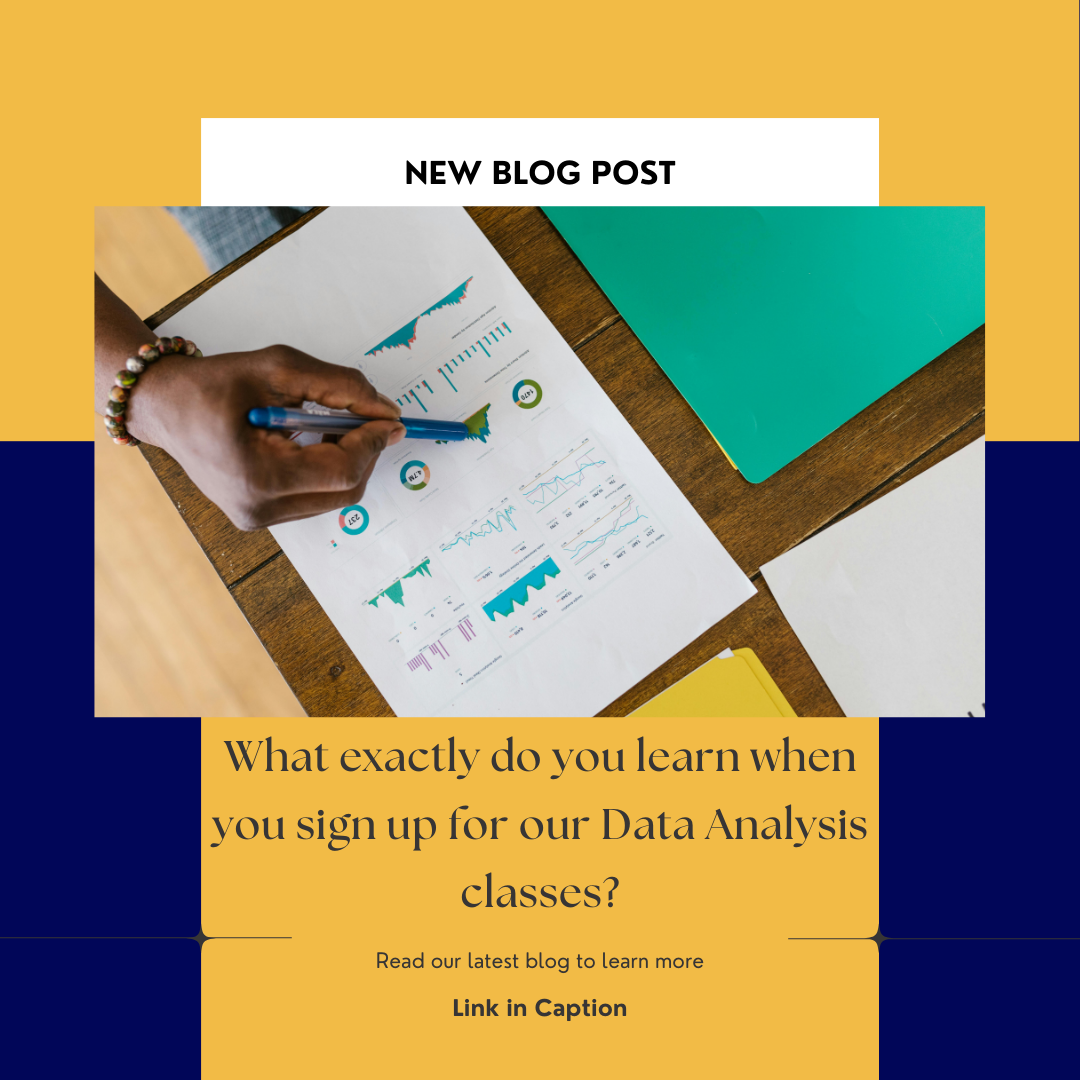In a world driven by data, companies are increasingly looking for skilled data analysts to help them turn raw data into actionable insights. Whether you’re a complete beginner or looking to sharpen your skills, our Data Analysis Bootcamp provides the hands-on experience and foundational knowledge you need to succeed in this high-demand field.

In this post, we’ll explore the beginner-friendly curriculum you’ll experience in our Data Analysis Bootcamp and highlight the exciting career prospects that await once you’ve mastered the art of data analysis.
Why Data Analysis?

Data analysis is at the heart of decision-making for businesses across every industry. As a data analyst, your job is to collect, process, and interpret data to help organisations make better decisions. From marketing to finance, data analysts provide insights that drive growth, improve efficiency, and uncover opportunities.
This skill set is in high demand, and with the rise of big data, companies are more eager than ever to hire analysts who can make sense of the vast amounts of information available to them.
What You’ll Learn in Our Data Analysis Bootcamp
Our bootcamp is designed to be beginner-friendly, starting from the basics and moving into more advanced data analysis concepts. Here’s a breakdown of the key topics you’ll cover:
1. Introduction to Data Analysis and Excel
Excel is one of the most versatile tools for data analysis. Mastering it will give you a solid foundation for more advanced tools and techniques.
We begin the bootcamp by teaching you the basics of data analysis and familiarising you with Microsoft Excel, one of the most widely used tools in the field.
Excel Basics: Learn how to input data, use formulas, and perform basic data cleaning and manipulation.
Data Summarization: Discover how to use functions like SUM, AVERAGE, and COUNT to extract key insights from data.
Data Visualization: Create charts and graphs to present your data in a clear, visual format.
Why it matters: Excel is one of the most versatile tools for data analysis. Mastering it will give you a solid foundation for more advanced tools and techniques.
2. Data Cleaning and Preparation:
The Foundation of Analysis
In the real world, data is often messy and inconsistent. Knowing how to clean data is a crucial skill for any data analyst, as it ensures the quality of your results.
Before you can analyze data, you need to clean and prepare it. This module focuses on data cleaning techniques to ensure that your datasets are accurate and ready for analysis.
Handling Missing Data: Learn how to deal with incomplete datasets.
Data Formatting: Understand the importance of consistent formatting for dates, text, and numerical values.
Outlier Detection: Discover how to spot and handle anomalies that could skew your analysis.
Why it matters: In the real world, data is often messy and inconsistent. Knowing how to clean data is a crucial skill for any data analyst, as it ensures the quality of your results.
3. Statistical Analysis: Understanding Your Data
Statistics is the backbone of data analysis. Knowing how to apply statistical techniques will enable you to draw meaningful conclusions from your data and provide actionable insights.
In this module, we’ll dive into the world of statistics, teaching you how to apply statistical methods to your datasets to uncover trends and relationships.
Descriptive Statistics: Learn how to calculate measures like mean, median, and standard deviation to summarize data.
Inferential Statistics: Discover how to use hypothesis testing and confidence intervals to make predictions based on sample data.
Correlation and Regression: Understand how variables are related and how you can use regression models to predict outcomes.
Why it matters: Statistics is the backbone of data analysis. Knowing how to apply statistical techniques will enable you to draw meaningful conclusions from your data and provide actionable insights.
4. SQL: Managing and Querying Databases
Most data is stored in databases, and SQL is the key to accessing and manipulating it. Understanding SQL will allow you to work efficiently with large datasets in a professional environment.
Next, you’ll learn how to use SQL (Structured Query Language) to manage and query databases. SQL is an essential tool for any data analyst, as it allows you to interact directly with databases and extract the data you need.
SQL Basics: Get familiar with basic SQL commands like SELECT, FROM, WHERE, and JOIN.
Database Management: Learn how to organize and structure data in relational databases.
Complex Queries: Discover how to write more advanced queries to filter, group, and aggregate data.
Why it matters: Most data is stored in databases, and SQL is the key to accessing and manipulating it. Understanding SQL will allow you to work efficiently with large datasets in a professional environment.
5. Introduction to Python for Data Analysis
Python is a must-know tool for data analysts today. It enables you to work with large datasets, automate tasks, and perform more complex analyses that go beyond what Excel can do.
As you progress, we’ll introduce you to Python, one of the most popular programming languages for data analysis. Python is known for its simplicity and versatility, making it an excellent choice for beginners.
Python Basics: Get comfortable with Python syntax, variables, loops, and functions.
Pandas: Learn how to use the Pandas library to manipulate and analyze data more efficiently.
NumPy: Use NumPy to perform mathematical and statistical operations on large datasets.
Why it matters: Python is a must-know tool for data analysts today. It enables you to work with large datasets, automate tasks, and perform more complex analyses that go beyond what Excel can do.
6. Data Visualization with Matplotlib and Seaborn
Visualizing data is a key part of data analysis. Being able to present your findings clearly and effectively is crucial for communicating insights to stakeholders.
Once you’ve mastered the basics of Python, we’ll move into data visualization using popular Python libraries like Matplotlib and Seaborn.
Matplotlib: Learn how to create basic plots, bar charts, and line graphs to represent your data.
Seaborn: Take your visualizations to the next level by creating more advanced charts like heatmaps and pair plots.
Why it matters: Visualizing data is a key part of data analysis. Being able to present your findings clearly and effectively is crucial for communicating insights to stakeholders.
Capstone Project: Analyze Real-World Data
A capstone project is a final, comprehensive project that students complete at the end of a course or program, designed to apply and showcase the skills and knowledge they've gained. It typically involves solving a real-world problem or completing a practical task related to the course of study. This is what you'll do at ITSkills Bootcamp
By the end of the bootcamp, you’ll apply everything you’ve learned in a capstone project. You’ll work with real-world datasets to conduct a full data analysis, from data collection to visualisation and reporting.
This project will serve as a portfolio piece to showcase your skills to potential employers.
Career Prospects for Data Analysts
Data analysis is one of the fastest-growing fields, with a variety of career opportunities. After completing our bootcamp, you’ll be prepared to pursue roles such as:
Data Analyst: Collect and interpret data to help organizations make better decisions.
Business Analyst: Use data to identify trends and help companies optimize their strategies.
Salaries for data analysts range from $60,000 to $90,000+ depending on experience and location, with demand for data professionals continuing to rise.
Why Join Our Data Analysis Bootcamp?
Our Data Analysis Bootcamp is designed to help beginners gain hands-on experience and build the skills needed to succeed in the field. With a blend of theory, practical exercises, and real-world projects, you’ll graduate ready to tackle the challenges of data analysis in a professional setting.
Start your journey into data analysis today! Enrol in our bootcamp and become a key player in the data-driven world. Enrol at www.itskillscentre.com.ng/apply
